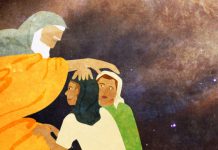Parashat Tetzaveh is also known as the “Garments of the High Priest.” This portion delves into the intricate details of the priestly garments and their significance in Jewish tradition.
The Garments of the High Priest
In the beginning of the parasha, God commands Moses to take oil, spices, and a variety of materials to create the garments of the High Priest, Aaron. These garments include the breastplate, ephod, robe, tunic, turban, and sash. The garments were designed to make Aaron appear distinguished and to remind the Jews of his important role as the High Priest.
The Importance of the High Priest
The High Priest was not an ordinary priest. He was the leader of the priestly caste and held a special position in Jewish society. The High Priest was responsible for performing the most important rituals in the Temple, including the Yom Kippur service. The garments were a visual representation of his authority and the Jews connection to God.
Symbolic Meanings
The garments also held symbolic meanings. The breastplate, known as the Choshen, was a square piece of fabric with 12 precious stones on it, each representing one of the tribes of Israel. The stones were arranged in four rows, with three stones in each row. The high priest wore the breastplate over his heart, representing his love and concern for the people he served.
The ephod, a sleeveless garment worn over the tunic, was made of gold, blue, purple, and scarlet yarns, and fine twisted linen. It had two shoulder straps which had two onyx stones each engraved with six names of the tribes of Israel. It was said that the ephod represented the priestly duties and responsibilities that the high priest had to bear on his shoulders.
The turban or mitre was also significant in that it bore a gold plate with the inscription “Holy to the Lord” on it. This symbolized the high priest’s role as the spiritual leader and his dedication to God.
Similarly, the High Priest’s breastplate also carried great significance, as it contained twelve precious stones, each representing one of the twelve tribes of Israel. The breastplate served as a reminder to the High Priest of the responsibility he held as a representative of the entire nation before God.
THE MESSAGE OF TETZAVEH FOR TODAY
In modern times, we no longer have a centralized place of worship or a Temple, and the Kohanim and High Priests no longer hold the same position of authority as in ancient times. However, the message of Parashat Tetzaveh is still relevant for us today.
One lesson we can take from this Parasha is the importance of taking pride in the way we present ourselves to others. Just as the Kohanim wore special garments to differentiate themselves from the rest of the nation, we too can make a conscious effort to dress appropriately and with respect for ourselves and those around us. This applies not just to our physical appearance but also to the way we conduct ourselves and the way we speak.
Another lesson we can learn is the importance of leadership and responsibility. The Kohanim and High Priests were held to a high standard and were responsible for guiding and leading the nation in spiritual matters. Today, we too have the responsibility to be leaders in our own communities and to set a positive example for those around us.
Finally, the symbolism of the Tabernacle serves as a reminder of the importance of creating a space for God in our lives. Just as the Jews built a physical structure to house the Divine presence, we too can create a spiritual home for God through prayer, study, and acts of kindness and compassion.
The Significance Today:
While we no longer have the tabernacle and its sacrificial system, the garments worn by the high priest hold a significant lesson for us even today. The garments were a reminder that those who serve God must do so with reverence, holiness, and a heart of love and concern for others.
Furthermore, the garments remind us of the importance of our role as a “kingdom of priests and a holy nation” (Exodus 19:6). As believers, we are called to be holy and set apart for God’s purposes, just as the high priest was set apart for his role.
Conclusion:
Parashat Tetzaveh reminds us of the importance of dressing and presenting ourselves in a respectable manner, taking on leadership roles and responsibility, and creating a space for God in our lives. By following these teachings, we can strive to live a life of purpose and meaning, connecting with God and with those around us.












